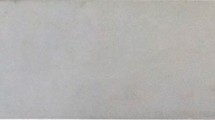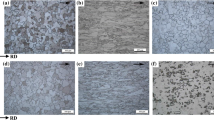Abstract
Recently, soft hot strip and hard hot strip produced through ferritic rolling are projected as a direct replacement to austenitic cold-rolled sheets for many forming applications. However, industrial hot-rolling mills, with final rolling thickness limitations cannot produce these thinner products and have to be subsequently cold-rolled to the desired application thickness and further annealed. Under ferritic rolling conditions, the hot-rolling temperature of these coils governs the final properties. The temperature difference in hot-rolled sheets generates the difference in the microstructure and texture of these coils after cold-rolling and annealing and variation in their formability behaviour. In the present work, an Nb–Ti stabilized IF grade steel was hot-rolled at two different temperatures in the ferritic regime and subsequently cold-rolled and annealed for structure-property comparison. As formability is an application-specific requirement, the annealed sheets were tested for different formability characteristics. Industrially rolled samples were tested for fracture criterion, stretch-flangeability, deep drawability and stretch formability through the formability limit diagram, hole expansion ratio, earing test and Erichsen cupping test respectively. These parameters were compared with those of the austenitic regime rolled sheets. High temperature ferritic rolled sheets show improved formability in all tests due to better \(\dot{{\text{r}}}\), higher n-value, low Δr and stronger gamma fibre maxima at 111<121>. Low temperature ferritic rolled sheets show the lowest Δr and improved n-value, but has reduced \(\dot{{\text{r}}}\) and higher alpha fibre texture. High temperature ferritic rolled sheets show higher formability limits in uniaxial tension and low temperature ferritic rolled sheets in biaxial tension of the FLD curve. Various tests established that high temperature ferritic rolled sheets are best suited for deep drawing and stretching applications whereas low temperature ferritic rolled sheets should be preferred for stretch forming applications.








Similar content being viewed by others
References
Schey J A 1992 Formability determination for production control. J. Mater. Process. Technology 32: 207–221
Animesh T, Vinit R C, Kapish M, Mukul V, Athar J and Mohit K S 2013 Formability Characteristics of Different Sheet Metals By Erichsen Cupping Testing With NDT Methods. Journal on Material Science 1: 14–18
Takahashi Manabu 2015 Sheet Steel Technology for the Last 100 Years. Progress in Sheet Steels in Hand with the Automotive Industry. ISIJ International 55(1): 79–88
Reddy A C S, Rajesham S, Reddy P R and Uma Maheshwar A C (2019) In: Formability- A Review on Different Sheet Metal Tests for Formability, International Conference on Multifunctional Materials (ICMM-2019), Hyderabad, India, 19-21 Dec: 1 -8
Narayanasamy R and Sathiya Narayanan C 2005 Forming limit diagram for interstitial free steels: part I. Material Science Engineering A 399: 292–307
Ravi Kumar D 2002 Formability analysis of extra deep drawing steel. J. Material Process. Technology 130: 31–41
Majumdar and Shrabani (2011) Formability limit diagram of high strength steel sheet (DP 590), International Journal of Mechanical Engineering, Aug 2011, 1(2): 114-118
Salunkhe Ujwala Sunil and Baba Pai K (2014) Investigation of formability of CRCA Steel sheet by Erichsen Cupping Test analysis, IOSR Journal of Mechanical and Civil Engineering (IOSR-JMCE), 11 (2): 52–55
Ghosh P, Ghosh C, Ray R K and Bhattacharjee Deepro 2008 Precipitation Behavior and Texture Formation at Different Stages of Processing in an Interstitial Free High Strength Steel. Scripta Materialia 59: 276–278
Wei-min Guo, Zuo-cheng Wang and Sheng Liu 2010 Mechanical Properties and Microstructures of Ferritic-Rolled High-Strength Interstitial-Free (IF) Steel Sheets. Advanced Materials Research 97–101: 416–419
Herman JC, Cantineaux P and Langlais, J M (1992) Future Prospects of Ferritic Hot- Rolled Thin Strip Steel: A new "Low Cost" approach for steel sheet production, Steel World, February : 48 - 54
Andreas Tomitz and Radko and Kaspar, 2000 Deep drawable Thin-gauge Hot Strip of Steel as a Substitution for Cold Strip. ISIJ International 40(9): 927–931
Barrett C J and Wilshire B 2002 The production of ferritically hot rolled interstitial-free steel on a modern hot strip mill. Journal of Materials Processing Technology 122: 56–62
Hiroshi T 1994 Metallurgical Aspects on Interstitial Free Sheet Steel from Industrial Viewpoints. ISIJ International 34: 1–8
Chang W, Yu W, Yang H, Man Z and Cao Y 2020 Effect of ferritic hot rolling process on microstructure and properties of IF steel. Mater Sci Forum 993: 505–512
Tiitto K M, JungC Wrav P, Garcia C I and Deardo A J 2004 Evolution of Texture in Ferritically Hot Rolled Ti and Ti + Nb Alloyed ULC Steels during Cold Rolling and Annealing. ISIJ International 44: 404–413
Ji-ping Chen, Yong-lin Kang, Ying-min Hao, Liu Guang-ming and Xiong Ai-ming 2009 Experimental Study on Ti+ Nb Bearing Ultra-Low Carbon Bake Hardening Sheet Steel Hot-Rolled in the Ferrite Region. International Journal of Minerals, Metallurgy and Materials 16: 540–548
Hao Lei-lei, Li Lang, Qiu Chen-yang, Wang Jian-gong, Zhou Xun and Kang Yong-lin 2019 Texture development and properties of Ti-IF steels produced by different hot-rolling processes. Iron Steel Research International 26: 310–320
Saha Rajib, Ray R K and Bhattacharjee D 2007 Attaining deep drawability and non-earing properties in Ti + Nb interstitial-free steels through double cold rolling and annealing. Scripta Materialia 57: 257–260
Ghosh P, Bhattacharya B and Ray R K 2007 Scripta Materialia 56: 657–660
Çinar Göktu ğ 2006 Effects Of Anisotropy On Formability In Sheet Metal Forming. Istanbul Technical University, Institute of Science and Technology, June, M.Sc.Thesis
Roberto and Gerardo Bruna 2011 Effects of hot and warm rolling on microstructure, texture and properties of low carbon steel. Metallurgy and Materials 64: 57–62
Ray R K, Jonas J J and Hook R E 1994 Cold rolling and annealing textures in low carbon and extra low carbon steels. International Materials Review 39(4): 129–172
Sperle J O and Olsson K (1994) In: High-Strength Automotive Sheet Steels for Weight Reduction and Safety Applications, High-Strength Steels for Automotive Symposium Proceedings, Baltimore, October : 65 - 75
Nakazima K, Kikuuma T and Hasuka K (1968) Study on the formability of steel sheets, Yawata technical report no.264: 41 – 154
De Saikat Kumar, Deva Anjana, Mukhopadhyay Siddhartha and Jha Bimal Kumar 2011 Assessment of Formability of Hot-Rolled Steel through Determination of Hole-Expansion Ratio. Materials and Manufacturing Processes 26: 37–42
Narayanasamy R, Sathiya Narayanan C, Padmanabhan Palani and Venugopalan T 2010 Effect of mechanical and fractographic properties on hole expandability of various automobile steels during hole expansion test. International Journal of Advanced Manufacturing Technology 47: 365–380
Chen Xinping, Jiang Haoming, Cui Zhenxiang, Lian Changwei and Chao Lu 2014 Hole expansion characteristics of ultra-high strength steels. Procedia Engineering 81: 718–723
Kim Jae Hyung, Kwon Young Jin, Lee Taekyung, Lee Kee-Ahn, Kim Hyoung Seop and Lee Chong Soo 2018 Prediction of Hole Expansion Ratio for Various Steel Sheets Based on Uniaxial Tensile Properties. Met. Mater. Int. 24(1): 187–194
Tajally M, Emaddodin E and Fathallah Qods (2011) An experimental study on earing and planar anisotropy of low carbon steel sheets, World Applied Sciences Journal, 15, January: 1 – 4
Liao Lu-hai, Zheng Xiao-fei, Kang Yong-lin, Liu Wei, Yan Yan and Mo Zhi-ying 2018 Crystallographic texture and earing behaviour analysis for different second cold reductions of double-reduction tinplate. International Journal of Minerals, Metallurgy and Materials 25(6): 652–662
Kim Y I, Kim J H, Kim Y, Lee M Y, Moon Y H and Kim D 2011 Formability evaluation of tailor-welded blanks of boron steel sheets by Erichsen cupping test at elevated temperature. Transactions of Materials Processing 20: 568–574
Song Y Q, Guan Z P, Ma P K and Song J W 2006 Theoretical and experimental standardization of strain hardening index in tensile deformation. Acta Metallurgica Sinica 42: 673–680
Rees D W A 2001 Factors influencing the FLD of automotive sheet metal. J. Material Process. Technology 118: 1–8
Author information
Authors and Affiliations
Corresponding author
Ethics declarations
Conflict of interest
The authors have no funding/conflict of interest/competing interests to declare that are relevant to the content of this article.
Rights and permissions
About this article
Cite this article
SATISH KUMAR, D., MANJINI, S. & UDAYA BHAT, K. Formability behaviour of ferritic and austenitic rolled Nb–Ti stabilized IF grade steel. Sādhanā 48, 9 (2023). https://doi.org/10.1007/s12046-022-02063-2
Received:
Revised:
Accepted:
Published:
DOI: https://doi.org/10.1007/s12046-022-02063-2




